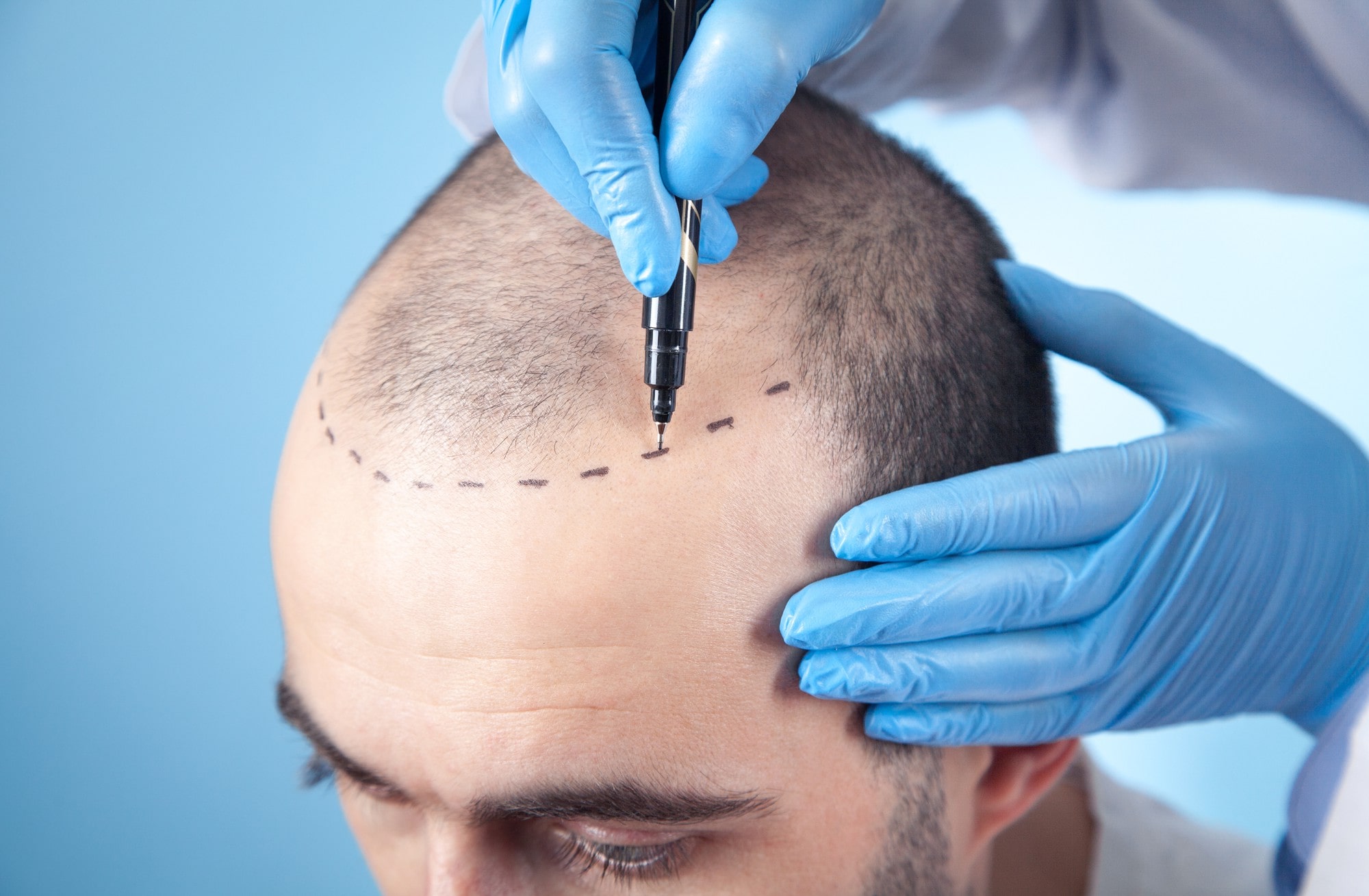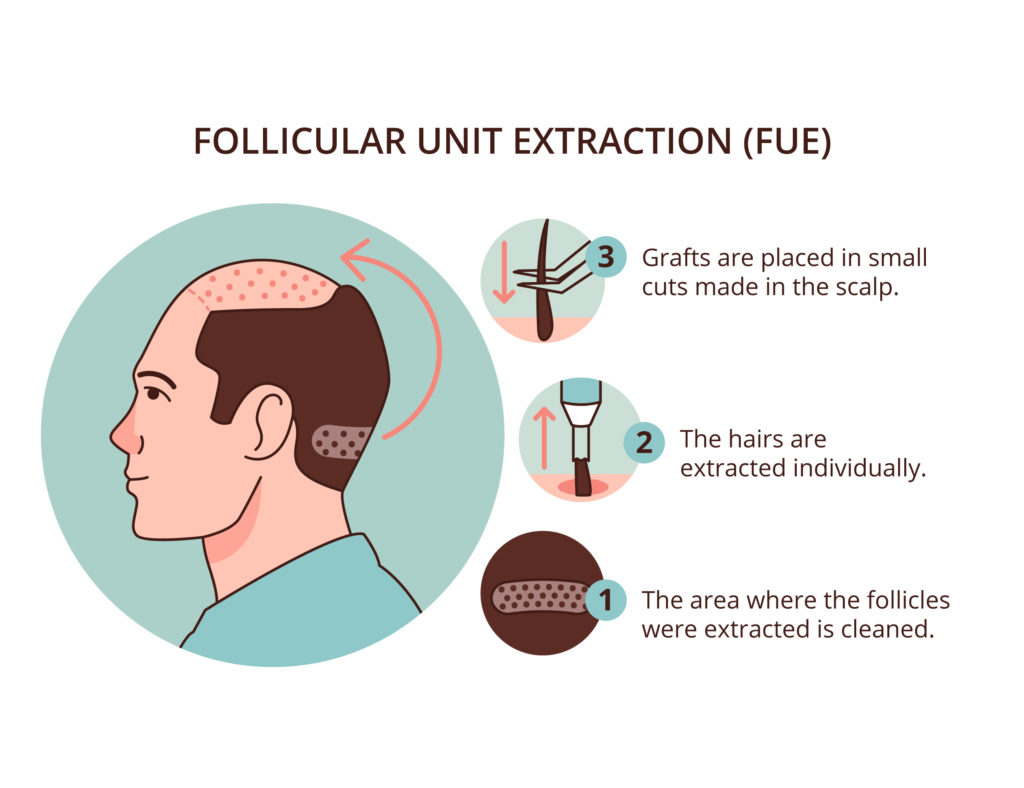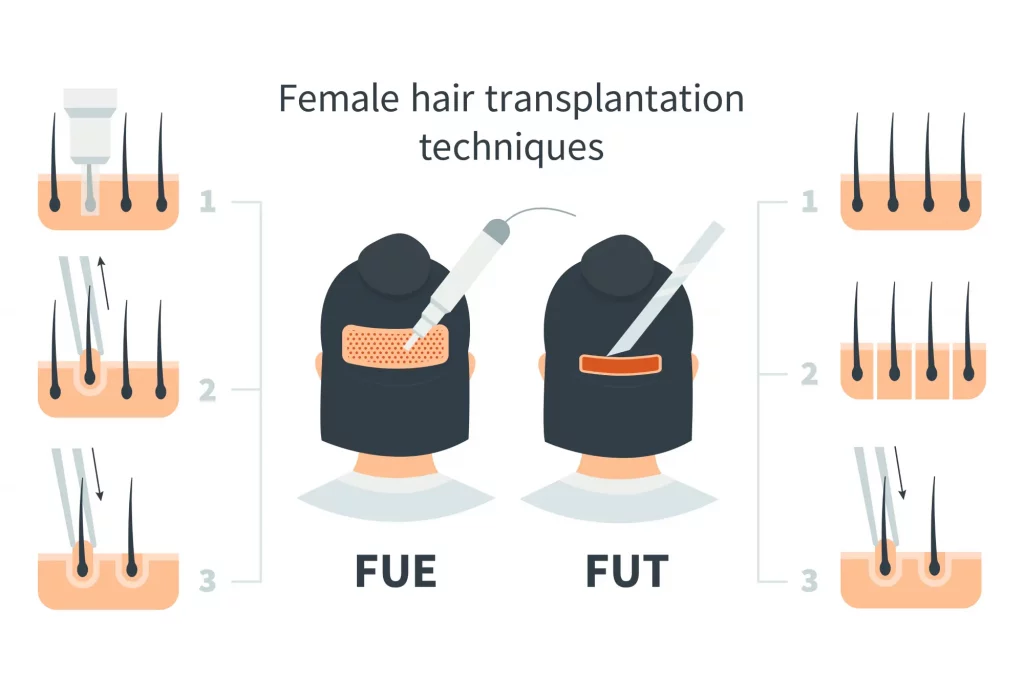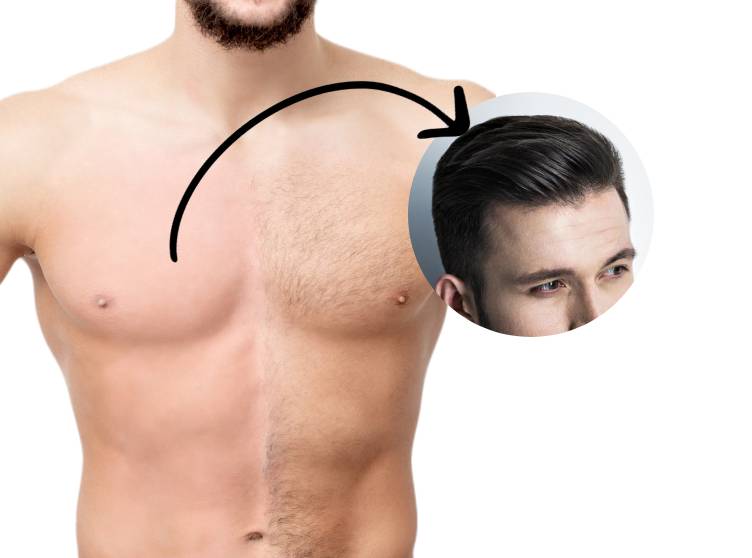
Antibes Hair Transplant
Hair loss can be a source of concern for many people, affecting their confidence and self-esteem in Antibes. Fortunately, hair restoration offers effective solutions for restoring a natural head of hair, whether through a hair transplant, a beard transplant or an eyebrow transplant in Antibes.
Hair transplantation in Antibes is a hair restoration procedure that offers a glimmer of hope to people suffering from permanent baldness, diffuse hair loss or scarring.
The hair transplant process
The Antibes hair transplant process involves the careful preparation of hair follicles from a donor area of the scalp, usually the crown or back of the head, for transplantation into balding or thinning areas. Two common techniques are used: FUE (Follicular Unit Extraction) and FUT (Follicular Unit Transplantation). FUE in Antibes involves the extraction of individual follicles, while FUT in Antibes involves taking a strip of hair and cutting it into follicular units.
Ideal candidates
Ideal candidates for hair, beard or eyebrow transplants in Antibes are generally men and women with permanent baldness, diffuse hair loss or scars resulting from surgery or injury. A consultation with a hair transplant specialist in Antibes will help assess whether the person is a good candidate for the procedure.
Expected results
After hair transplantation in Antibes, patients can expect gradual, natural regrowth of the transplanted hair, beard or eyebrows in the months following the procedure. Once healing is complete, hair, beard or eyebrows will grow like normal hair, allowing patients to regain a more youthful, confident appearance in Antibes.

The FUE technique for hair, beard and eyebrow transplants in Antibes
Follicular Unit Extraction (FUE) hair transplantation is a widely used method for hair restoration, including beard and eyebrow transplantation in Antibes. It stands out for its meticulous, less invasive approach compared with the strip method (FUT). Here’s how the FUE technique works.
- Individual removal of hair follicles: Unlike the FUT method, which involves cutting a strip of skin containing hair follicles, FUE involves removing each follicle individually. At Antibes, this procedure is carried out using a small circular instrument, 0.8 millimeters in diameter. The specialized practitioner makes small incisions around each follicle, then gently extracts them from the skin using ophthalmic tweezers.
- Follicle preparation: Once harvested, hair follicles are sorted, cleaned and prepared for transplantation, whether for hair, beard or eyebrow transplants. At Antibes, follicular units are selected according to their quality and type, sometimes up to 4 hairs per follicular unit
- Follicle transplantation: The prepared follicles are then implanted in the recipient areas, where hair, beard or eyebrow loss is visible. In Antibes, the team creates small incisions in the recipient area following a natural pattern of hair growth, including inclinations and directions, then inserts the follicles one by one into these incisions.
- Healing and regrowth: After transplantation, the follicles enter a resting phase and the transplanted hairs fall out. However, it is essential to understand that follicles remain alive, and after a while, new hair, beard hair or eyebrows begin to grow back from these follicles. In Antibes, regrowth can take several months before full results become visible.
The FUE technique offers several advantages over the FUT method, particularly in Antibes:
- No linear scarring: FUE generally leaves no visible linear scar, unlike the FUT method, which leaves a scar where the strip of skin is removed.
- Faster recovery: FUE tends to result in faster recovery, as it does not involve extensive suturing or prolonged healing time of the donor area.
- Possibility of harvesting follicles from different areas: The FUE technique allows follicles to be harvested from different parts of the body, which can be useful if the donor area on the scalp is limited.
However, it is essential to note that in Antibes, the FUE technique requires considerable expertise to obtain natural and aesthetic results, whether for a hair, beard or eyebrow transplant. Experienced hair transplant teams in Antibes can tailor the FUE technique to each patient’s unique characteristics to achieve the best possible results. Before deciding to undergo an FUE hair, beard or eyebrow transplant in Antibes, it is advisable to consult a specialist healthcare professional to discuss your needs and expectations.
The FUT technique – Strip Hair Grafting in Antibes
Hair transplants are an increasingly popular option for those looking to restore their hair, whether on the head, beard or eyebrows. In Antibes, FUT (Follicular Unit Transplantation) is a well-established method of hair restoration. Here’s how it works:

- Strip removal: In Antibes, the hair transplant surgeon marks and anesthetizes the donor area, usually located at the back or sides of the head, where hair is thicker and less prone to shedding. Next, a strip of skin is carefully removed using a surgical scalpel. This strip contains hair follicles, blood vessels and supporting tissue.
- Suturing the donor area: After removing the strip, the donor area is sutured to close the wound. Sutures may be dissolving or may need to be removed after a set period of time.
- Follicle preparation: The strip is then cut into smaller follicular units, usually called micrograft or minigraft. These units are sorted and cleaned ready for transplanting.
- Creating incisions in the recipient area: The surgeon creates small incisions in the recipient area (where hair loss is visible) following a natural pattern of hair growth. These incisions are crucial in determining the angle, direction and density of transplanted hair regrowth.
- Follicle implantation: The micrografts or minigraft are carefully implanted one by one into the incisions created in the recipient area. The surgeon takes care to follow the natural pattern of the hair to achieve an aesthetically consistent result.
- Healing and regrowth:After transplantation, a healing period is necessary. Transplanted hair usually falls out in the weeks following the procedure, but the follicles remain active. New hair will gradually begin to grow back over the following months.
The FUT technique was one of the first hair transplant methods used in Antibes and has proven its effectiveness for many patients, whether for a hair transplant on the head, a beard transplant or an eyebrow transplant. However, it is important to note that it leaves a linear scar at the donor site, which can be an inconvenience for some patients. This scar is usually hidden by the growth of the surrounding hair, but it can be a worrying factor for those who prefer to wear their hair very short.
If you are considering a hair, beard or eyebrow transplant in Antibes, it is strongly recommended that you consult a specialist healthcare professional to discuss your options and determine the best approach based on your needs and expectations. Hair transplants in Antibes can be an effective solution for regaining a natural, confident appearance.

Hair transplant for women in Antibes
Female hair transplants, Antibes beard transplants, Antibes eyebrow transplants, and Antibes beard transplants for men, share similarities, but present specific considerations due to variations in hair loss patterns between the sexes. Women, just like men, can experience hair loss due to factors such as genetics, aging, hormonal imbalances, stress, and other medical conditions. Thus, hair transplantation may be an option to consider to solve these problems, but it is essential to note that hair loss patterns in women can be more diffuse and extensive than in men. Therefore, planning an Antibes beard hair transplant, Antibes eyebrow transplant or Antibes beard transplant for women must include a careful assessment of the donor and recipient areas.
Here are some considerations specific to hair transplantation for women.
- Precise assessment: A Antibes beard hair transplant specialist will carefully assess the donor and recipient areas to determine the feasibility of the transplant. Women with smaller donor areas may require strategic planning to achieve satisfactory results.
- Hair density: In general, women have a higher hair density at the back of the head (donor area) than men. This feature can be advantageous for harvesting sufficient hair follicles for transplantation.
- Hair loss patterns: Hair loss patterns in women differ from those seen in men. Women can experience diffuse hair loss all over the head, unlike typical male pattern baldness. This difference can influence the way follicles are harvested and transplanted.
- Realistic expectations : t’s essential that women have realistic expectations regarding hair transplant results. Hair restoration can improve the appearance and density of hair, but it does not guarantee 100% thick, full hair.
- Specialized consultation: Before making the decision to undergo an Antibes beard hair transplant, Antibes eyebrow transplant or Antibes beard transplant, it is essential to consult a specialist experienced in hair restoration. This consultation will provide an opportunity to discuss options, expectations and likely outcomes.
In the end, whether it is a hair transplant for women, a beard transplant Antibes, an eyebrow transplant Antibes or a beard transplant Antibes, each case is unique and must be treated with care and professionalism.
Hair transplants in Antibes use the BHT technique (Body Hair Transplant)
Hair transplants in Antibes, including beard and eyebrow transplants, use the BHT (Body Hair Transplant) technique to solve hair loss problems. This innovative method involves harvesting hair follicles from various parts of the body, such as the chest, back and shoulders, and transplanting them to the scalp.
Hair transplantation in Antibes using the BHT technique is particularly suitable when the conventional donor area at the back of the head does not provide sufficient hair follicles or when the hair density in this area is insufficient. Here are the general steps of the procedure:

- Body hair harvesting: Using the FUE (follicular unit extraction) method, body hair is carefully harvested from areas where hair growth is denser, which may include the chest, back and shoulders.
- Follicle preparation: Hair follicles harvested from body hair are sorted and prepared in the same way as scalp follicles.
- Follicle transplantation: Prepared follicles are carefully transplanted onto the scalp in recipient areas where hair loss is evident. A specialized team makes small incisions in the recipient area and inserts the follicles one by one.
- Healing and regrowth: Transplanted follicles go through a resting period, and it’s common for transplanted hairs to fall out before new ones begin to grow back. Complete regrowth can take several months.
Hair transplantation in Antibes, including beard and eyebrow transplants, is a valuable solution for patients with advanced hair loss, insufficient hair density in the traditional donor area, or scars on the scalp that make conventional hair transplantation difficult. However, it is important to note that body hair has different characteristics to scalp hair, particularly in terms of texture and growth rate, which can influence the results of hair transplantation in Antibes.
Make an appointment for a hair transplant
The first hair transplant consultation is free to determine the best approach for your individual needs.
Antibes, a City at the Heart of the French Riviera
The old town of Antibes and its protective dike

Antibes, located on the French Riviera in the southeast of France, is a city that seamlessly blends history, culture, and natural beauty. With a population of around 75,000, it stretches between Nice and Cannes, offering a unique mix of traditional charm and modernity.
The History of Antibes
The history of Antibes goes back to antiquity. Founded by the Greeks in the 5th century B.C. as Antipolis, it became an important trading city. Later, under the Roman Empire, Antibes continued to prosper, as evidenced by the archaeological remains still visible today.
The historic heart of Antibes is its old town, with narrow, winding cobblestone streets lined with pastel-colored buildings. Key attractions include the Provençal market, where visitors can find local products such as herbs, olives, and cheeses. The Notre-Dame-de-l’Immaculée-Conception Cathedral, dating from the 12th century, is another gem, featuring a mix of medieval, Gothic, and Baroque architecture.
The Famous Port of Antibes: Port Vauban
The city is also famous for its port, Port Vauban, the largest marina in the Mediterranean. It houses sumptuous yachts and serves as a starting point for many sea excursions. The port is also home to the renowned Fort Carré, a 16th-century fortress offering panoramic views of the city and sea.
The Picasso Museum in Antibes
Antibes has a strong connection with art, having attracted numerous artists over the years. Pablo Picasso, one of the most famous, spent part of 1946 working in the Château Grimaldi, now the Picasso Museum. This museum houses an impressive collection of his works, as well as works by other modern artists.
The Beaches of Antibes
The nature around Antibes is also remarkable. The city is surrounded by fine sandy beaches and rocky coves. La Salis beach is one of the most popular, offering a beautiful view of the Alps and the Cap d’Antibes. For nature lovers, the Cap d’Antibes coastal path is a picturesque walk winding along the coast, offering spectacular views of the Mediterranean.
The Local Cuisine
The cuisine in Antibes is typically Mediterranean, focusing on fresh seafood, olive oil, and market vegetables. Local restaurants offer a range of traditional and innovative dishes, allowing visitors to taste the authentic flavors of the region.
Culture in Antibes
Cultural events abound in Antibes. The most famous is undoubtedly the Jazz à Juan Festival, held each summer in Juan-les-Pins, part of the commune of Antibes. This festival has seen performances by jazz legends like Miles Davis and Ray Charles and continues to attract renowned musicians.



